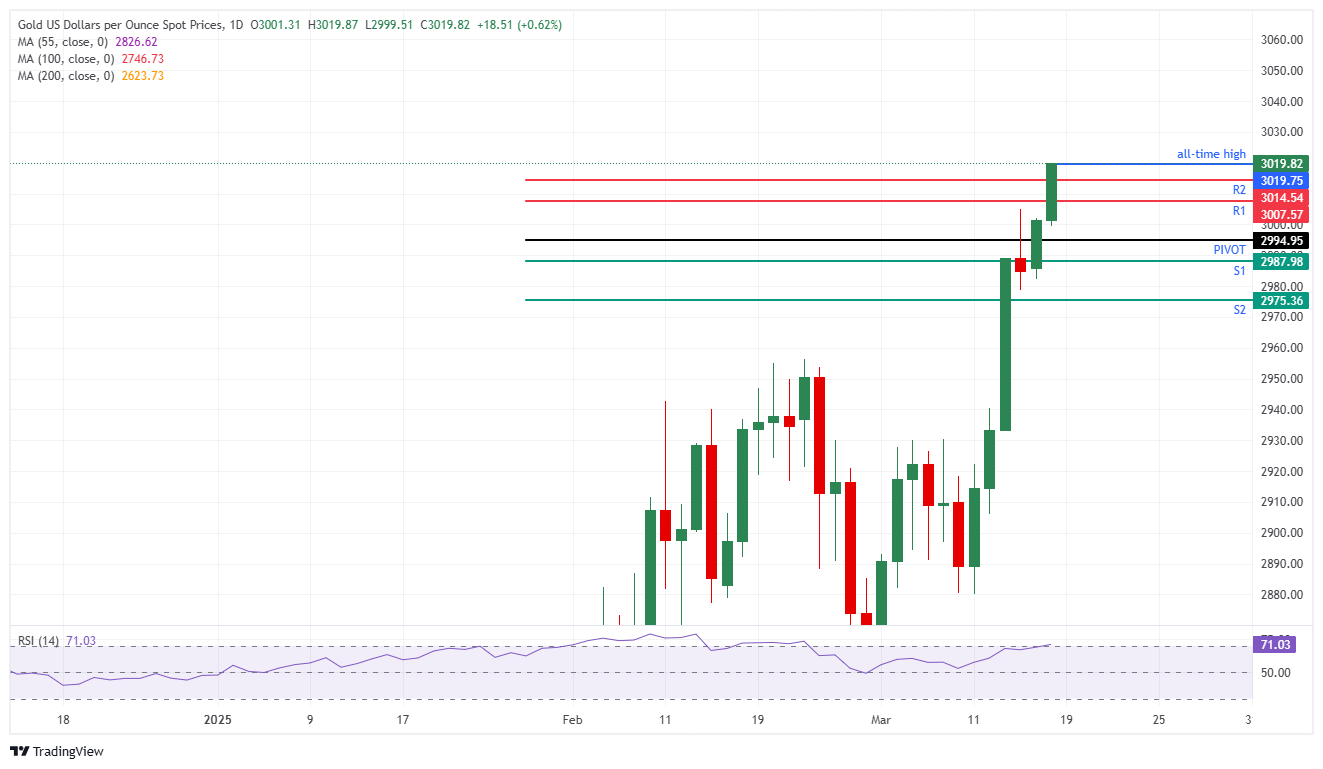Gold extends the new all-time highs with phone call between Trump and Putin set to take place

- Gold advances and sets forth a fresh all-time high.
- Traders add to their positions in the precious metal after Israeli strikes on Gaza end the ceasefire deal.
- Gold has room to stretch higher with a German vote on spending and the Trump-Putin phone call up ahead.
Gold’s price (XAU/USD) surges again and reaches a fresh all-time high currently at $3,028 on Tuesday. The precious metal trades around $3,021 at the time of writing. The rise comes after Israel executed military operations on possible Hamas tactical positions and buildings. The move is seen as the end of the ceasefire deal, which started in January and is likely to bring more Red Sea attacks by Houthi rebels and retaliation by Hamas as a counter-response to the recent intervention by Israel.
The ceasefire failure comes just hours before United States (US) President Donald Trump has a phone call with Russian President Vladimir Putin to reach a final deal to end the war in Ukraine. Concerns are plentiful after Trump said on Sunday that Russia and the US are dividing assets amongst themselves, which would mean that Ukraine has no word in the process while Trump bypasses the North Atlantic Treaty Organisation (NATO) and the European Union (EU). Meanwhile, the German parliament, the Bundestag, will vote this Tuesday on a new budget that could boost defense spending by roughly $49 billion, Bloomberg reports.
Daily digest market movers: Expectations are elevated
- Just hours before the possible historic phone call between US President Trump and Russian President Putin, details are leaked on the demands from Russia before concluding a deal. One of those demands is that President Putin demands an immediate end to the arms being delivered to Ukraine, according to Bloomberg.
- Several analysts are pointing out that sluggish US data is another driver that benefits Gold. The influx of buyers on this commodity on Monday after rather sluggish US Retail Sales numbers shows that as the economic sentiment in the US turns, Gold is benefiting from traders looking for safe-haven assets, Bloomberg reports.
- With the upcoming Federal Reserve (Fed) meeting on Wednesday, the odds to keep interest rates at the current range are at 99%. Meanwhile, rate cut odds for next June’s meeting are at 68.6%, according to the CME Fedwatch tool.
- The global Silver market is under stress as trade-war concerns unsettle investors, with key indicators flashing red, millions of ounces on the move between trading hubs, and months of disruption in prospect. A surge in rates to borrow the precious metal has become the latest sign of alarm, according to Yahoo Finance.
Technical Analysis: Where to go from here
Gold traders have several reasons and arguments for one would push Gold higher. As several banks start to call $3,200, it sets a clear target for the coming weeks and months. However, traders will need to keep in mind that once markets are positioned in one single direction, that is the moment when the turnaround could occur.
The daily resistance levels R1 and R2 have already been taken out on Tuesday. That means the big figures are being used as guidance from here on out. Look for $3,020 and $3,030 as the following anchor points in the intraday trading.
On the downside, the intraday R1 and R2 resistances should be acting as support now. So that means $3,014 and $3,007 should support any brief pullbacks. The intraday Pivot Point at $2,994 is the first line of defense in case the $3,000 level cracks under selling pressure.
XAU/USD: Daily Chart
Fed FAQs
Monetary policy in the US is shaped by the Federal Reserve (Fed). The Fed has two mandates: to achieve price stability and foster full employment. Its primary tool to achieve these goals is by adjusting interest rates. When prices are rising too quickly and inflation is above the Fed’s 2% target, it raises interest rates, increasing borrowing costs throughout the economy. This results in a stronger US Dollar (USD) as it makes the US a more attractive place for international investors to park their money. When inflation falls below 2% or the Unemployment Rate is too high, the Fed may lower interest rates to encourage borrowing, which weighs on the Greenback.
The Federal Reserve (Fed) holds eight policy meetings a year, where the Federal Open Market Committee (FOMC) assesses economic conditions and makes monetary policy decisions. The FOMC is attended by twelve Fed officials – the seven members of the Board of Governors, the president of the Federal Reserve Bank of New York, and four of the remaining eleven regional Reserve Bank presidents, who serve one-year terms on a rotating basis.
In extreme situations, the Federal Reserve may resort to a policy named Quantitative Easing (QE). QE is the process by which the Fed substantially increases the flow of credit in a stuck financial system. It is a non-standard policy measure used during crises or when inflation is extremely low. It was the Fed’s weapon of choice during the Great Financial Crisis in 2008. It involves the Fed printing more Dollars and using them to buy high grade bonds from financial institutions. QE usually weakens the US Dollar.
Quantitative tightening (QT) is the reverse process of QE, whereby the Federal Reserve stops buying bonds from financial institutions and does not reinvest the principal from the bonds it holds maturing, to purchase new bonds. It is usually positive for the value of the US Dollar.
